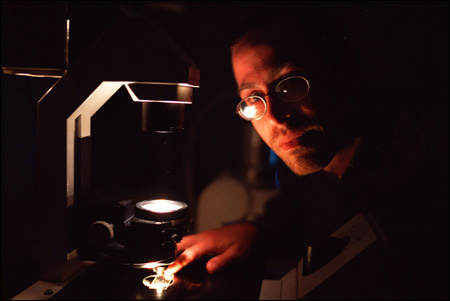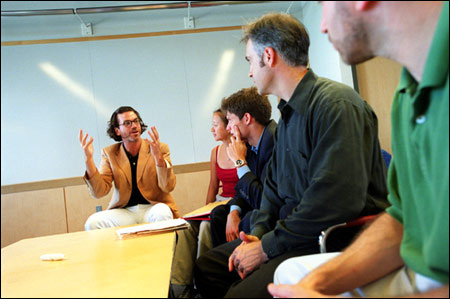Undergrad students develop system to fight TB:
There’s a new type of attack on tuberculosis

Harvard undergraduate students, working with their professors, are developing a new technology for treating tuberculosis (TB). The new system delivers drugs through an inhaler, increasing the likelihood that patients will take them over longer periods, and reducing the side effects of pills and injections. To test and market the system, the group has formed a nonprofit corporation called MEND (MEdicine in NeeD).
“It’s the beginning of an effort to bring new technology from the labs and classrooms of Harvard to patients by the quickest means possible,” according to David Darst, a 21-year-old junior. “It’s a first as far as we know.”
“We started a course to give students the opportunity to translate classroom science into practical medical treatments,” adds David Edwards, Gordon McKay Professor of Biomedical Engineering in the Division of Engineering and Applied Sciences (DEAS).
Centered at DEAS, this effort includes two other biotechnology startups. One is focused on protecting against bioterrorist attacks on livestock by countering the spread of airborne germs, such as those that cause foot-and-mouth disease. The other hopes to come up with a noninvasive method of pet neutering.
MEND is farthest along. The students have talked with doctors and TB patients in South Africa and raised enough support to test the technology on rats.
TB claims about 2 million lives every year. India, China, and Africa are hot spots, and the disease is increasing at a worrisome rate in Eastern Europe and nations that were formerly members of the Soviet Union.
Getting patients to take a full course of drugs looms as one of the big problems in eradicating TB. “When patients feel bad, they go for treatment,” explains Nicolas Tsapis, a postdoctoral fellow working with MEND. “After two to three months, they feel better, then they stop taking their medications. But they need six months of therapy to cure the disease.”
Drugs given by injection are painful and have toxic side effects. Pills are easier to take, but they, too, can cause liver and stomach problems including nausea, diarrhea, and vomiting.
Giving the drugs via an inhaler sidesteps these problems by bypassing the stomach and liver, and delivering the medication directly into the lungs.

A Trojan horse attack
Getting medicinal particles deep into the lungs before they are exhaled or are engulfed by cells from the body’s immune system presented a problem until it was solved by Tsapis, Edwards, and their colleagues. Relatively large particles, measured in hundredths of thousandths of an inch, only penetrate as far as the mouth, nose, or throat. There, the microparticles get attacked by large white blood cells, called macrophages, which surround and destroy them. (This is the defense system that keeps you from swallowing dust, smoke, and other harmful pollutants in dirty air.) So-called nanoparticles, thousands of times smaller, can avoid these defenses and get into the deepest reaches of the lungs. But most of these invisible specks are exhaled along with stale air.
Edwards and his co-workers solved the first part of the problem five years ago by engineering microparticles that are so light and porous they go deep into the lungs, but are still large enough to avoid attack by the defense cells. Edwards formed a company to use this technology for drug delivery, and in 1999 the company merged with Alkermes, Inc., in Cambridge. Working with Alkermes researchers, Edwards, Tsapis, and Gordon McKay Professor of Applied Physics David Weitz created a way to put the nanoparticles inside the microparticles. They call the result “Trojan particles,” which they hope will attack TB bacteria the way Greek soldiers, hidden in a huge wooden horse, assaulted their enemies in Troy. Once in the lungs, it is hoped, the large porous particles will dissolve and release the nanoparticles so deep they won’t be exhaled.
The feat is described in the Sept. 17 issue of the Proceedings of the National Academy of Sciences.
Edwards proposed working on further development of this strategy to students taking a course called “Biomedical Startups,” which he teaches with Gordon McKay Professor of Chemical Engineering and Applied Mathematics Howard Stone. The idea struck David Darst and other students as cool and challenging. “It was something I wanted to be part of,” says Darst, an economics and government major who co-founded a biotechnology company during a year that he took off after high school.
The students split into groups. One began working on how to get TB drugs into the form of nanoparticles. A second tackled the calculations of how fast and how deep the Trojan particles could travel. Darst leads a third group charged with handling the business end.
MENDing patients
One of the first obstacles is money. The MENDers traveled to New York this summer to pitch their idea to organizations like the Global Alliance for TB and the Rockefeller Foundation.
To date, MEND has received about $200,000 of in-kind contributions, and it hopes to raise more money through what Darst calls “angel funding.” Experiments already done on rats show that drugs can be successfully delivered to the deepest parts of the lungs where TB infections can reside. “Many more tests are needed before we get to trials with humans,” Darst admits.
Such results and a show of interest from drug companies, the United Nations, and the World Health Organization have laid the groundwork for preparing more funding proposals.
In the meantime, Tsapis, Darst, and three other students traveled to South Africa in August to probe the acceptance of TB inhalers.
The group described their new system to patients, nurses, and doctors at TB clinics in the Cape Town area, and asked their opinions about the new technology. “We explained that inhalers could make possible lower doses of drugs,” Tsapis notes. “Yet, because the drugs don’t pass through the stomach, they would reach the lungs in higher concentrations than they would with pills or injections.”
“Our inhalers, designed by Alkermes to use Edwards’ technology, resemble small pipes,” Darst points out. “Patients liked the shape and feel of them. Since many patients are also infected with the AIDS virus and have difficulty getting to a clinic everyday, the doctors and nurses agreed that inhalers could increase the likelihood that patients will continue taking the drugs even when they feel better.”
Tsapis calls the outcome of their visit “very encouraging.”
Edwards notes that “these small inhalers may also become a new way to deliver drugs to patients with asthma, cystic fibrosis, and other lung diseases, even lung cancer.
Meanwhile, other student scientist-entrepreneurs are working on different technologies to protect cattle and pigs from terrorist attacks with inhaled particles such as the virus that causes foot-and-mouth disease. “At present, veterinarians try to stop the spread of the disease by slaughtering all the animals in a 10-kilometer radius from infected animals,” Edwards says. “As recent outbreaks in Europe have demonstrated, that doesn’t work well. We think that the emission of special aerosols into the air might do the trick. The technique might even be used in advance to minimize the risk of an outbreak in the first place.”
The students also are exploring whether aerosols might be used to eliminate the pain of neutering cats and dogs, if the right combination of drugs and nanoparticles can be engineered.
The whole program is not only a first for medical treatments, it’s a first for education. Instead of being confined to classroom lectures and reading assignments, students actually work on a one-to-one basis with scientists, lawyers, and business people, form their own corporations, and work on solutions to practical problems.




